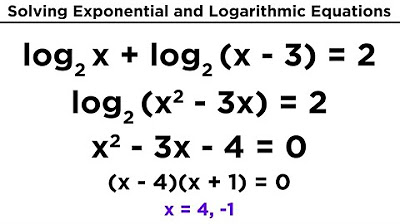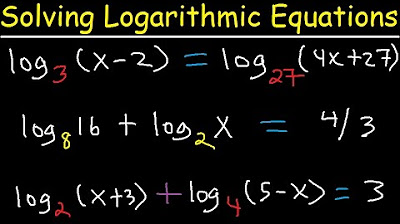Solving Exponential Equations
TLDRThe transcript outlines a series of mathematical problems involving exponential equations, where the base and exponent are manipulated to solve for the variable x. It demonstrates various methods, such as changing bases, working with common bases, and simplifying complex expressions to find the values of x. The process involves both algebraic manipulation and the use of logarithms where applicable, showcasing a step-by-step approach to problem-solving in exponential equations.
Takeaways
- 🔍 To solve exponential equations without logs, convert bases to make them the same and then equate the exponents.
- 📐 The script demonstrates solving exponential equations by transforming them into linear equations through base manipulation.
- 🔢 In the first example, the equation 3^(x+2) = (3^2)^(2x-3) is solved by changing bases and simplifying to find x = 8/3.
- 🔧 The process of 'taking logs' is avoided by using properties of exponents and base changes, as shown in the examples.
- 🌟 The script shows how to find the common base by relating numbers to their powers, such as 2^3 = 8 and 2^4 = 16.
- ✅ The method of factoring is used to solve equations where possible, such as in the case of 3^(x^2 + 4x) = 1/27.
- 📌 The technique of dividing by a common base involves subtracting exponents, as shown in the last example with 3^(2x - (2x-1)) = 3^(-1).
- 📈 The script also covers solving equations with a sum and difference of exponents, like in 3^(2x) - 3^(2x-1) = 18.
- 🔑 The use of natural logs is recommended when dealing with base 'e', as opposed to regular logs.
- 📊 The script provides a step-by-step approach to solving each problem, emphasizing the importance of understanding the properties of exponents.
- 🎯 The final answers are verified by plugging them back into the original equations to ensure their correctness.
Q & A
How can we solve the equation 3^(x+2) = 9^(2x-3) without using logarithms?
-We can change the base 9 to base 3, since 3^2 equals 9. This transforms the equation to 3^(x+2) = 3^(4x-6). If the bases are the same, the exponents must be equal, leading to the equation x + 2 = 4x - 6. Solving this linear equation gives us x = 8/3.
What is the common base for the numbers 8 and 16, and how is it used to solve the equation 8^(4x-12) = 16^(5x-3)?
-The common base for 8 and 16 is 2, since both numbers are powers of 2 (2^3 = 8 and 2^4 = 16). We replace 8 with 2^3 and 16 with 2^4. The equation becomes 2^(12x-36) = 2^(20x-12). By setting the exponents equal to each other, we get 12x - 36 = 20x - 12. Solving for x yields x = -3.
In the example 27^(3x-2) = 81^(2x+7), how do we determine the values for x?
-We replace 27 with 3^3 and 81 with 3^4. The equation becomes 3^(9x-6) = 3^(8x+28). Setting the exponents equal to each other gives us 9x - 6 = 8x + 28. Solving this equation, we subtract 8x from both sides and add 6 to both sides to find that x = 34.
What method is used to find the value of x when 3^x = 8?
-We take the logarithm of both sides of the equation. Since the base is not specified, it defaults to base 10. This transforms the equation to x * log(3) = log(8). To solve for x, we divide both sides by log(3), resulting in x = log(8) / log(3), which approximately equals to 1.8928.
How do we approach the equation e^x = 7?
-We take the natural logarithm (ln) of both sides of the equation. This transforms the equation to ln(e^x) = ln(7). Since ln(e^x) simplifies to x, we are left with x = ln(7), which is the exact answer. The decimal approximation is about 1.9459.
What is the strategy for solving the equation 5 + 4^(x-2) = 23?
-We first isolate the term with the exponent by subtracting 5 from both sides, resulting in 4^(x-2) = 18. Since 18 is not a power of 2, we take the logarithm (or natural logarithm) of both sides. This transforms the equation to (x-2) * log(4) = log(18). Solving for x gives us x = 2 + log(18) / log(4), which approximately equals to 4.08496.
How do we solve the equation 3^(x^2 + 4) = 1/27?
-Since 1/27 is 3^(-3), we have the equation 3^(x^2 + 4) = 3^(-3). By setting the exponents equal, we get x^2 + 4 = -3. However, this equation has no real solutions because a square of a real number cannot be negative.
What are the steps to find the value of x in the equation 2^(x^2) * 2^(3x) = 16?
-We first replace 16 with 2^4, resulting in the equation 2^(x^2 + 3x) = 2^4. By setting the exponents equal, we get x^2 + 3x = 4. This is a quadratic equation, and we can solve it by factoring or using the quadratic formula. Factoring gives us (x + 4)(x - 1) = 0, leading to two solutions: x = -4 or x = 1.
How do we tackle the equation 4^(2x) - 20 * 4^(x) + 64 = 0?
-We can use substitution to solve this quadratic equation in exponential form. Let a = 4^x. Then the equation becomes a^2 - 20a + 64 = 0. Factoring this quadratic equation gives us (a - 4)(a - 16) = 0, leading to a = 4 or a = 16. Since a = 4^x, we have two solutions: x = 1 (for a = 4) and x = 2 (for a = 16).
What is the process for finding the value of x in the equation 3^(2x) - 3^(2x-1) = 18?
-We factor out the common term 3^(2x) from both sides, resulting in 3^(2x) * (1 - 3^(-1)) = 18. Simplifying further, we get 3^(2x) * (1 - 1/3) = 18, which simplifies to 3^(2x) * (2/3) = 18. Multiplying both sides by 3/2 gives us 3^(2x) = 27. Since 27 is 3^3, we have 2x = 3, leading to x = 3/2.
Outlines
📚 Solving Exponential Equations without Logs
This paragraph introduces a method for solving exponential equations without using logarithms. It demonstrates how to change the base of the equation to simplify the problem. The first example shows how to convert a base of nine to a base of three, which allows for the exponents to be equated after simplifying the equation. The process is then applied to a second example, where the bases are converted to two to find a common denominator. The paragraph emphasizes the importance of understanding the manipulation of exponents and bases to solve these types of equations effectively.
🔢 Using Logs for Solving Exponential Equations
This paragraph discusses the use of logarithms to solve exponential equations. It begins by showing how to take the log of both sides of an equation to isolate the variable. The first example involves finding the value of x when three to the power of x equals eight. By taking the log of both sides, the exponent is moved to the front, and the value of x is found by dividing the log of eight by the log of three. The paragraph then presents a natural log example, where the value of x is found by taking the natural log of both sides and isolating x. The process is further illustrated with additional examples, each highlighting the application of logarithms in solving exponential equations.
🧩 Factoring and Simplifying Complex Exponential Equations
This paragraph focuses on the technique of factoring and simplifying complex exponential equations. It starts by addressing a case where the bases are the same but the exponents are not, leading to a factoring process that results in two possible solutions for x. Another example involves multiplying exponents with a common base, which simplifies to an equation that can be factored to find the values of x. The paragraph also covers the method of factoring by substitution, which transforms a complex equation into a quadratic form, allowing for the determination of x. The examples provided illustrate the step-by-step process of simplifying and solving complex exponential equations through factoring and substitution.
🔄 Dividing Exponents and Simplifying Equations
The final paragraph delves into the division of exponents and the simplification of equations. It presents an example where a complex term is simplified by factoring out the greatest common factor (GCF). The process involves dividing terms with the same base and subtracting the exponents, leading to a simplified form of the equation. The paragraph then shows how to solve for x by manipulating the terms and using the properties of exponents. The detailed explanation of dividing exponents and the step-by-step solution of the equation demonstrate the application of algebraic techniques in solving exponential equations.
Mindmap
Keywords
💡exponential equation
💡base conversion
💡exponents
💡logarithms
💡equating exponents
💡factoring
💡natural log
💡subtracting from both sides
💡distributing
💡division of exponents
💡quadratic equation
Highlights
The method of changing base nine to base three to solve the exponential equation 3^(x+2) = 9^(2x-3).
Replacing nine with three squared to simplify the equation.
Equating the exponents when the bases are the same to find the value of x in the equation.
Solving for x by isolating the variable and manipulating the equation.
The process of converting numbers to a common base to solve the equation 8^(4x-12) = 16^(5x-3).
Using the properties of exponents to replace 8 and 16 with 2 to the third and fourth power respectively.
Setting up and solving a linear equation involving exponents after converting to a common base.
The strategy of replacing numbers with their equivalent exponential form to solve 27^(3x-2) = 81^(2x+7).
Equating the exponents after setting the bases equal to each other in the equation.
Solving for x by simplifying and factoring the equation involving exponents.
The approach of taking the natural log of both sides to solve the equation 3^x = 8.
Using logarithms to find the exact and approximate values of x in the given equation.
The method of taking the natural log to solve equations involving base e, as shown in the example e^x = 7.
Subtracting a constant from both sides and applying logarithms to solve the equation 5 + 4^(x-2) = 23.
The process of dividing both sides by a constant and applying logarithms to find the value of x.
Solving the equation 3 + 2e^(3-x) = 7 by manipulating the equation and applying natural logarithms.
The method of factoring and simplifying to find the values of x in the equation 3^(x^2 + 4) = 1/27.
Using factoring to find the potential values of x when the equation involves multiplying exponents with a common base.
The process of factoring by substitution and reducing the equation to a quadratic form to solve 4^(2x) - 20*4^x + 64 = 0.
Solving for x by setting up and solving a quadratic equation after factoring by substitution.
The approach of factoring out the greatest common factor (GCF) to simplify and solve the equation 3^(2x) - 3^(2x-1) = 18.
Solving for x by dividing both sides by a term and simplifying the resulting expression.
Transcripts
Browse More Related Video

Solving Exponential Equations with Logarithms (Precalculus - College Algebra 64)

Solving Exponential Equations with Common Bases (Precalculus - College Algebra 54)

Introduction to Solving Logarithms and Exponentials (Precalculus - College Algebra 57)

6 to the (3x + 5) = 1, many don’t know where to start

Solving Exponential and Logarithmic Equations

Solving Logarithmic Equations With Different Bases - Algebra 2 & Precalculus
5.0 / 5 (0 votes)
Thanks for rating: